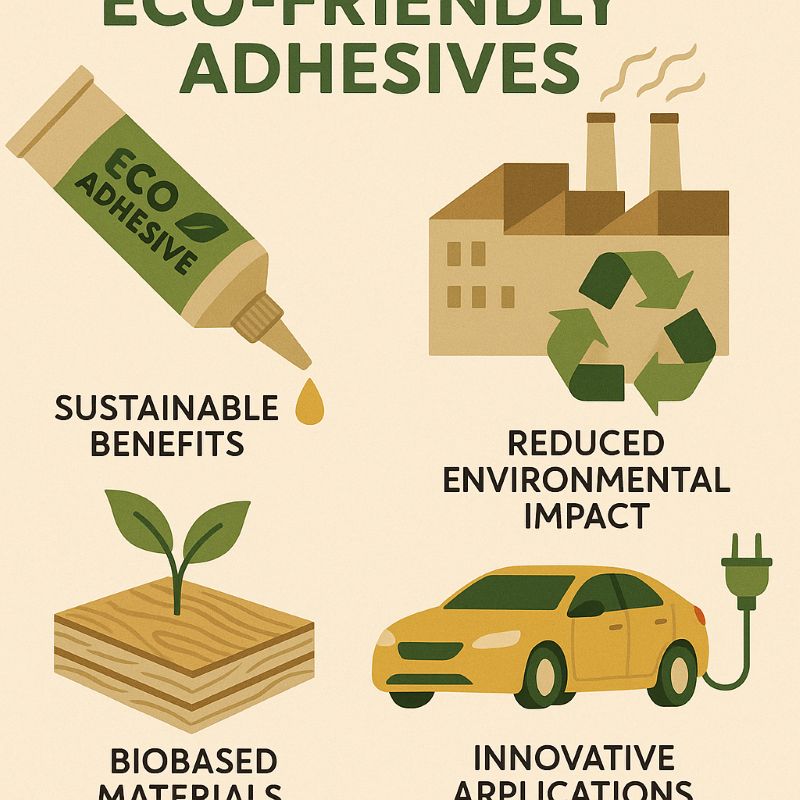
Definition of Eco-Friendly Adhesives
Types of Innovative Adhesives
Importance in Modern Industries
Methods of Adhesive Application
Latest Trends in Adhesive Technology
Strategies for Industry Adoption
Future of Eco-Friendly Adhesives
Frequently Asked Questions (FAQ)
Eco-friendly adhesives are transforming industries by offering sustainable alternatives to traditional bonding solutions. These adhesives are designed to minimize environmental impact, often derived from renewable resources and featuring low VOC emissions. Instead of relying on petrochemical-based formulations, eco-friendly adhesives emphasize durability and ecological responsibility, supporting industries striving to reduce their carbon footprint.
Eco-friendly adhesives encompass a wide range of innovative solutions, each addressing unique industrial needs.
Construction-grade adhesives: provide robust bonding strength while being formulated with sustainable components.
Packaging-grade adhesives: balance biodegradability with reliable adhesion, supporting environmentally conscious supply chains.
Medical-grade adhesives: emphasize safety, non-toxicity, and biocompatibility while minimizing ecological impact.
Woodworking adhesives: utilize renewable raw materials to deliver dependable performance for carpentry and furniture making.
These categories demonstrate how sustainable innovation can reduce environmental burdens while maintaining performance standards across diverse industries.
The importance of eco-friendly adhesives lies in their ability to replace conventional adhesives without sacrificing quality. They are reshaping sectors such as construction, packaging, healthcare, and woodworking by offering solutions that reduce carbon footprints, minimize waste, and prevent harmful chemical leaching. Their integration sets new performance benchmarks while helping industries align with global sustainability initiatives.
The effectiveness of eco-friendly adhesives is closely tied to the method of application.
Traditional methods such as brush and roller remain relevant for small-scale use.
Spray systems improve coverage and reduce waste in large-scale operations.
Automated dispensers ensure precision, especially in medical or high-accuracy applications.
By employing these methods, industries enhance efficiency while minimizing material waste, thereby reinforcing the environmental benefits of using sustainable adhesives.
The adhesive industry is experiencing a significant shift towards eco-conscious design. Key trends include:
Increased use of bio-based raw materials such as starch, cellulose, and plant proteins.
Advances in biodegradability, ensuring adhesives break down into harmless substances.
Integration of automation and precision application technologies to reduce waste.
These developments show how adhesives are evolving beyond their functional role to become drivers of sustainability in manufacturing and product design.
Adopting eco-friendly adhesives requires careful planning:
Assessment: Review current adhesive usage and identify areas where sustainable alternatives can be integrated.
Pilot programs: Test eco-friendly adhesives in real-world conditions to evaluate compatibility and performance.
Collaboration: Work with suppliers for tailored solutions, technical guidance, and reliable supply.
Education: Train employees on application methods and sustainability benefits to ensure smooth implementation.
Through these strategies, industries can transition effectively while maintaining high standards of quality and efficiency.
The future of eco-friendly adhesives is promising, driven by tightening global regulations and growing consumer demand for sustainable products. Advancements in bioengineering, enhanced biodegradability, and renewable sourcing are expected to further improve performance while reducing ecological footprints. Industries that adopt these adhesives early will not only meet environmental standards but also gain a competitive edge in sustainable innovation.
What are eco-friendly adhesives?
They are bonding solutions made from renewable or low-impact resources, designed to reduce emissions, waste, and long-term ecological harm.
What types are available?
Major categories include construction-grade, packaging-grade, medical-grade, and woodworking adhesives.
Why are they important for modern industries?
They help businesses reduce carbon footprints, meet sustainability targets, and comply with stricter regulations without compromising quality.
What application methods are used?
Eco-friendly adhesives can be applied using brushes, rollers, spray systems, or automated dispensers depending on the scale and precision required.
What trends define current adhesive technology?
Key trends include the use of renewable raw materials, advanced biodegradability, and improved application technologies.
How can industries adopt them effectively?
Through assessment, pilot testing, supplier collaboration, and workforce education.
What does the future hold?
Expect advancements in bio-based materials, improved durability, and greater adoption across sectors like packaging, construction, and healthcare.
How do they benefit the environment?
They reduce landfill accumulation, prevent harmful chemical leaching, and support circular economy practices by decomposing safely after use.